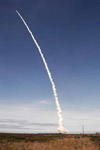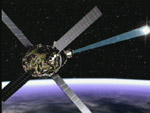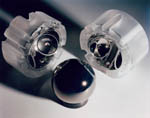WEEKLY HIGHLIGHTS FOR 28 MAY 2004:
GRAVITY PROBE B MISSION UPDATE

At five weeks past launch, the Gravity Probe B team is now about half way through the Initialization and Orbit Checkout (IOC) phase of the mission. Thus far, the team has successfully transmitted over 5,000 commands to the spacecraft, which remains healthy on orbit. All spacecraft subsystems are continuing to perform well. The spacecraft’s orbit is stable, meeting our requirements for next month’s transition into the science phase of the mission. All four gyros are now digitally suspended, and the team is in the process of locking the on-board telescope onto the guide star, IM Pegasi.
- This past week, the team began spinning up the gyros. During this complex
and delicate process, which spans the entire second half of IOC, each of
the four gyros undergoes a series of spin-up and testing sequences, the first
of which gets the gyros spinning—but at a very slow speed. Because
the correct performance of the gyros is critical to the success of the experiment,
the team is proceeding through the spin-up process slowly, painstakingly
monitoring and checking the performance of the gyros throughout the process.
- In preparation for spin-up, the digital suspension system for each gyro
was first tested. This was accomplished by suspending each gyro in the center
of its housing, electrically “nudging” it slightly off center
in one of eight directions (the corners of a cube), and monitoring its automatic
re-centering. This checkout was first performed under low voltage conditions
(fine control) and then under high voltage conditions (secure hold).
- To begin the actual spin-up process, ultra-pure helium gas was flowed over
gyro #1 and gyro #4 for 15 seconds, which started them spinning at approximately
0.125 Hz (7.5 rpm). While these gyros were slowly spinning, the suspension
test was repeated under high voltage conditions on gyros #2 and #3. During
this high voltage suspension test on gyro #3, the team discovered an error
in its command template, which turned off the high voltage amplifier to gyro
#1 and caused it to lose suspension. There was no damage to gyro#1.

- More than 1,000 commands have now been sent to the Gyro Suspension System
(GSS), and this was the first error found. Discovering an error in these
numerous, intricate command templates was exactly the kind of situation that
the painstaking gyro spin-up process was designed to identify; it enabled
the team to correct the command template for gyro #3 without serious consequences.
Also, as a further precaution, the team has thoroughly reviewed the command
templates for the remaining three gyros. Gyros #2 and #3 have now been spun-up
to 0.26 Hz (15 rpm) and 0.125 Hz (7.5 rpm) respectively without incident,
and gyro #1 is currently being spun-up, as well.
- Over the past week, much progress has been made towards the goal of locking the spacecraft’s on-board telescope onto the guide star. The pointing error of the spacecraft has been reduced to within 385 arc-seconds (0.11 degrees). This allows the on-board telescope to see the guide star over a portion of a spacecraft roll cycle. The team is in the process of fine-tuning the spacecraft’s attitude by adjusting the navigational gyroscope in the Attitude and Translation Control (ATC) system, so that the telescope will be able to see the guide star throughout the entire spacecraft roll cycle, and the team hopes to lock onto the guide star by the beginning of next week..

The spacecraft is being controlled from the Gravity Probe B Mission Operations Center, located here at Stanford University. The Stanford-NASA/MSFC-Lockheed Martin operations team is continuing to perform superbly.
Please Note: During the Initialization & Orbit Checkout (IOC) Phase of the GP-B mission, we will update this Web site and send out an email update once a week (usually on Thursday or Friday) to keep you apprised of our progress. From time to time, we may post and email extra updates, as warranted by mission events.
Photos and drawing: The first photo, showing the vapor trail of the Delta II rocket and payload after launch was taken by photographer Bill Hartenstein. The photo of the GP-B gyroscope rotor (sphere) and housings was taken by photographer Don Harlan. The drawing of the GP-B spacecraft on orbit, was extracted from an animation created by Adam Jeziak and Aaron Pozzer. This animation is part of a 26-minute movie about GP-B, entitled Testing Einstein's Universe (see description below). Click on the thumbnails to view enlarged copies of these images.
TRACKING THE GP-B SPACECRAFT
Find the Gravity Probe B satellite in the sky at NASA's satellite tracking web site. See where GP-B is with respect to the terminator (the day-night boundary on the Earth's surface), or just enter your zip code to see if GP-B might be over your neighborhood. The best time to look for it is usually at dusk.
Also, you can track the GP-B spacecraft on your Palm OS or Pocket PC Personal Digital Assistant (PDA), using either PocketSat or PocketSat+ from Big Fat Tail Productions. Both products are PDA Shareware, so you can try them out for free. If you decide to use them, Big Fat Tail asks that you pay a nominal shareware fee.
LEARN MORE ABOUT THE GP-B GUIDE STAR, IM PEGASI
For an overview about why we chose IM Pegasi as our guide star, and its importance to the GP-B mission, see our Guide Star FAQ.
Also, the ETH Institute of Astronomy in Zurich, Switzerland, is working with the Harvard-Smithsonian Center for Astrophysics to provide detailed optical information about the GP-B guide star, IM Pegasi. You can find out about the ETH Institute's work in monitoring magnetic activity on IM Pegasi and the Doppler Imaging Technique used for this purpose on the ETH Institute of Astronomy GP-B Web page.
FOLLOW IOC ACTIVITIES AND LEARN MORE ABOUT GRAVITY PROBE B
If you are interested in following the IOC procedures more closely, you'll find a schedule and description of them on pages 12-14 of the Gravity Probe B Launch Companion. This document also provides an overview and explanation of the Gravity Probe B experiment and information about the spacecraft and GP-B's amazing technologies. Click here to download the GP-B Launch Companion in Adobe Acrobat PDF format. (Please note: this file is 1.6 MB, so it may take awhile to download if you have a slow Internet connection.)
Norbert Bartel, Professor of Astrophysics and Space Sciences at York University in Toronto, Canada, has produced and directed a 26-minute documentary movie about the Gravity Probe B experiment entitled, Testing Einstein's Universe. This movie, along with 80 minutes of additional video about relativity, physics, and astronomy is available on a DVD, which you can purchase from the Website: http://www.astronomyfilms.com/
VIEW A VIDEO OF THE GP-B LAUNCH
 Click
here to view a 3 1/2 minute QuickTime video clip of the GP-B launch, produced
by the Stanford News Service. Please note that the video requires Quick Time to play.
Click here to
link to
download Quick Time.
Click
here to view a 3 1/2 minute QuickTime video clip of the GP-B launch, produced
by the Stanford News Service. Please note that the video requires Quick Time to play.
Click here to
link to
download Quick Time.![]()
FOLLOWING THE GP-B MISSION ON THE WEB
In addition to this Web site, here are some other Web sites that have information, photos, and video of the GP-B launch and mission.
- The ELV Missions Virtual Launch Center Web page on the John F. Kennedy Space Center Web site has information and several streaming video clips covering the GP-B mission. (You can view these video clips free of charge, but you will need to have either the Real Media Player or Windows Media Player installed on your computer to view them.)
- NASA's Marshall Space Flight Center Gravity Probe B.com Web page has a number of great photos from the GP-B launch, including photos of the spacecraft separation, as well as other information about Gravity Probe B.
- The Science @ NASA Web site, hosted by NASA's Marshall Space Flight Center, posts several stories each month about scientific research projects in which NASA is involved. This site currently features two general interest stories about Gravity Probe B: In search of Gravitomagnetism and A Pocket of Near Perfection. (In addition to the Web versions, these stories are also available in both plain text and streaming audio formats.)
- Photographer William G. Hartenstein's Web site has an extraordinary set of photos that he took on launch day.
- Another very comprehensive source of information about the GP-B launch is the Spaceflight Now Web site. This site contains an excellent photo gallery, as well as a number of Quicktime video clips of the launch. However, you have to become a subscriber to this site ($$$) in order to view the video clips.
GRAVITY PROBE B IN THE NEWS
Sunday evening, April 18th, a feature story about Gravity Probe B and principal investigator, Francis Everitt, aired on ABC World News Tonight. Click here to read a text version of the ABC News story. Also on April 18th, NPR's David Kestenbaum talked with GP-B's principal investigator, Francis Everitt on the program All Things Considered. On Friday, April 16th, Gravity Probe B Co-Principal Investigator, John Turneaure, was interviewed by Ira Flatow on NPR Talk of the Nation—Science Friday.
On Tuesday, April 13,2004, Gravity Probe B was the lead story in the Science section of the New York Times, and it was one of the front page stories in the San Jose Mercury News. (You'll need to register on the Web sites of these newspapers to view these stories online.) In addition, a story about GP-B appeared on the New Scientist Web on April 13, 2004.
The official pre-launch Gravity Probe B mission and science briefing was held on Friday, April 2, 2004 at 1:00 PM Eastern Daylight Time at NASA Headquarters in Washington, D.C. The participants in the briefing (pictured from left to right in the photo) were:

- Anne Kinney, Director of Astronomy/Physics Division, NASA Headquarters
- Rex Geveden, Program Manager, GP-B and Deputy Director, NASA's Marshall Space Flight Center in Huntsville, Alabama.
- Francis Everitt, GP-B Principal Investigator at Stanford University, Stanford, California
- Bradford Parkinson, GP-B Co-Principal Investigator at Stanford University, Stanford California
- Kip Thorne, Feynman Professor of Theoretical Physics, California Institute of Technology, Pasadena, California
You can view a Real Player streaming video of this briefing on the Kennedy Space Center GP-B Web site.
RECEIVE GRAVITY PROBE B WEEKLY HIGHLIGHTS BY EMAIL
If you are interested in automatically receiving these weekly highlights and other important GP-B mission information by email, you can subscribe to our Gravity Probe B Update email list by sending an email message to "majordomo@lists.Stanford.edu" with the command "subscribe gpb-update" in the body of the message (not in the Subject line). You can unsubscribe from this mailing list at any time by sending an email message to the same address with the command, "unsubscribe gpb-update" in the body of the message.
Previous Highlight
Index of Highlights
